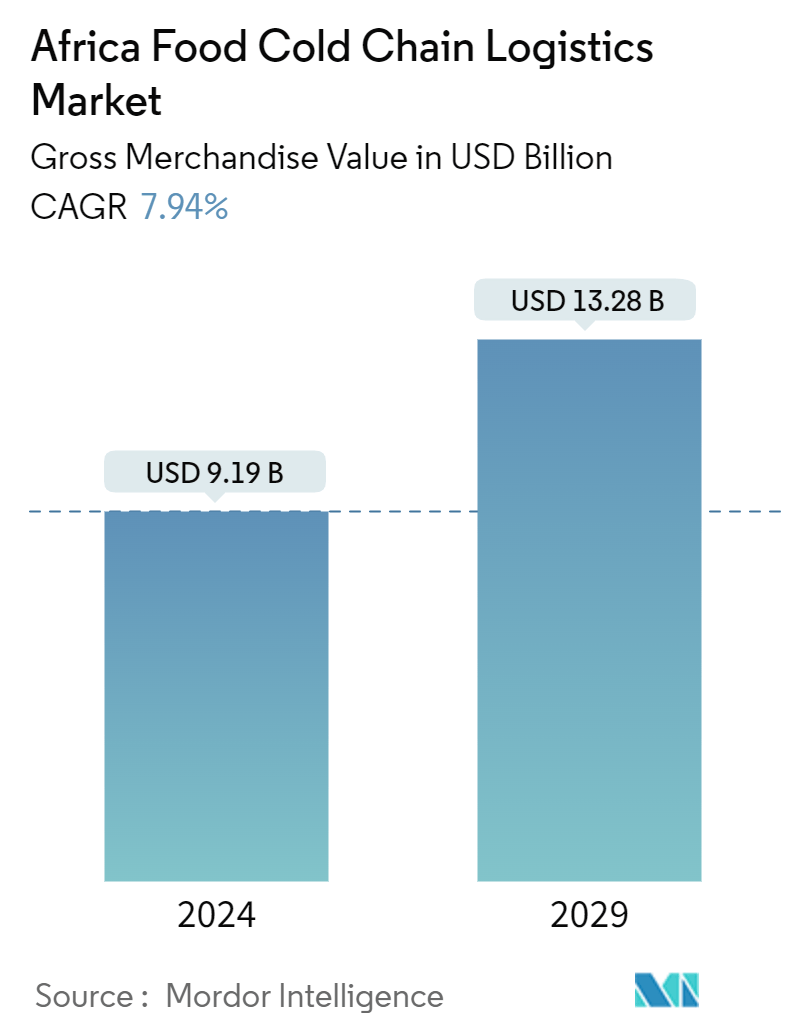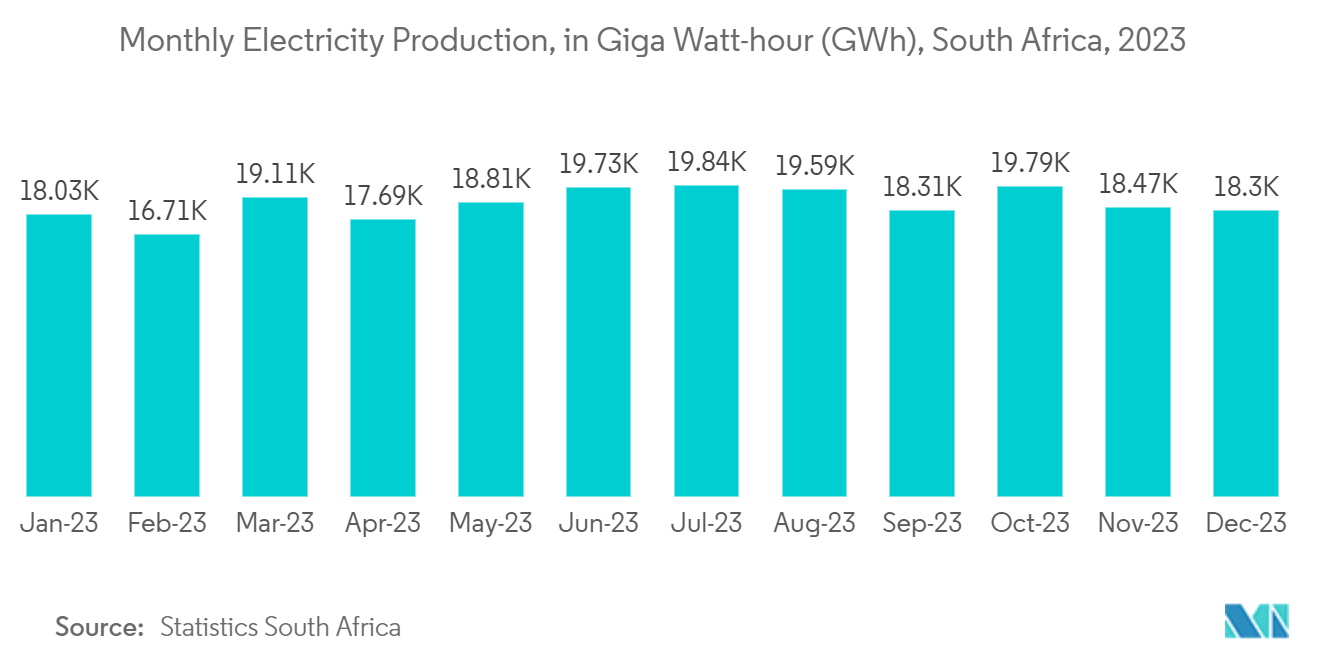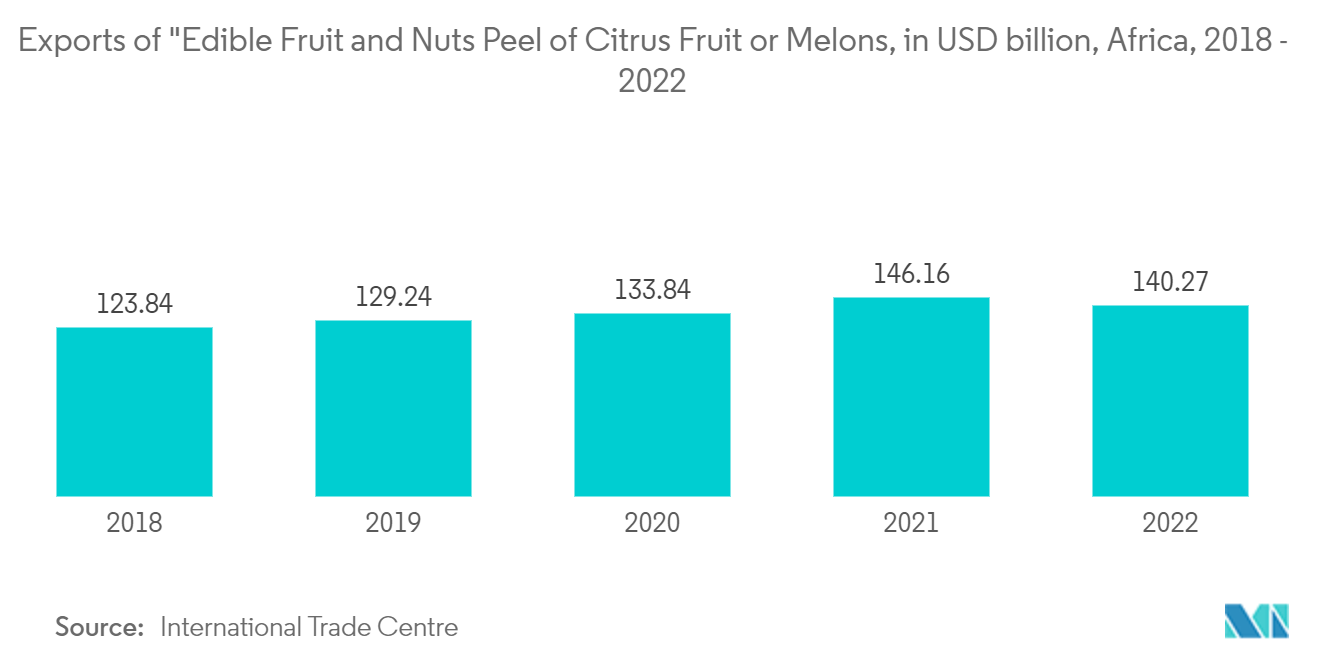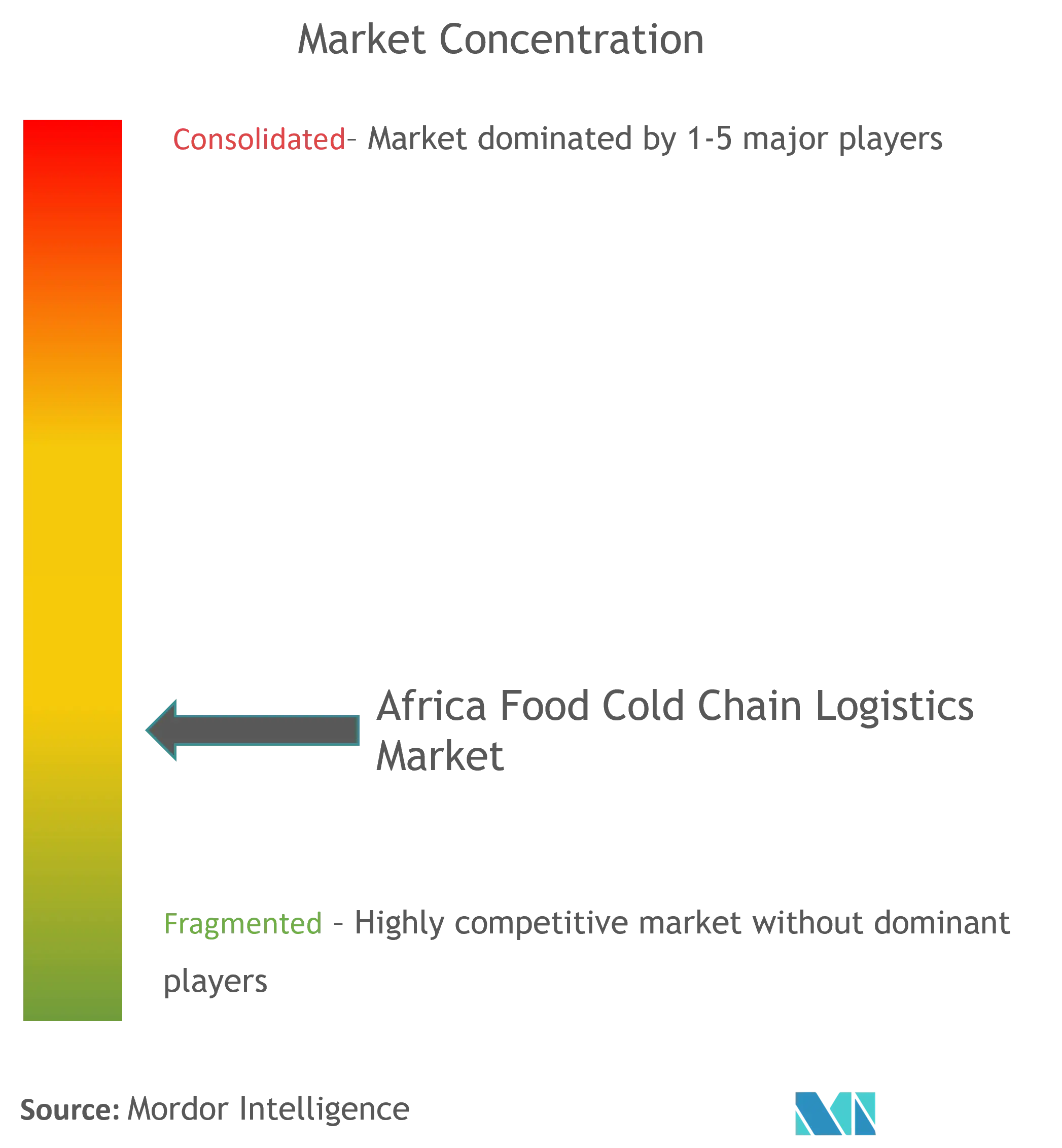Africa Food Cold Chain Logistics Market Size

| Study Period | 2020 - 2029 |
| Base Year For Estimation | 2023 |
| Market Size (2024) | USD 9.19 Billion |
| Market Size (2029) | USD 13.28 Billion |
| CAGR (2024 - 2029) | 7.94 % |
| Market Concentration | Low |
Major Players
*Disclaimer: Major Players sorted in no particular order |
Africa Food Cold Chain Logistics Market Analysis
The Africa Food Cold Chain Logistics Market size in terms of gross merchandise value is expected to grow from USD 9.19 billion in 2024 to USD 13.28 billion by 2029, at a CAGR of 7.94% during the forecast period (2024-2029).
Changes in lifestyle and urbanization contributing to increased domestic consumption of processed foods and a shift in consumption patterns, including increased consumption of fresh fruits, as people become more health concerned, need to address food wastage and ensure food security, are the factors assisting the market's growth.
The climate change crisis has significantly contributed to the dire food insecurity and food wastage in Africa. Over one-third of food produced in Africa is estimated to be lost to spoilage or waste. The United Nations Food and Agriculture Organization estimates that over 40% of food in Sub-Saharan Africa perishes before it reaches a consumer. This can be as high as 60% for fresh produce in Sub-Saharan Africa.
The leading cause of food wastage is spoilage due to the lack of cold storage facilities to extend the shelf life, especially temperature-sensitive food items. Farmers and agri-traders in Africa rely on makeshift coolers or outdated, generic cold rooms. These systems are unreliable, poorly maintained, and have high operational costs.
Cold storage or cold supply chain products can help reduce spoilage and maintain quality and efficacy, but they require sufficient electricity to work effectively. In Africa, according to the African Development Bank (AfDB), electricity is out of reach for more than 640 million people, and the ability to sustainably maintain constant cold temperatures remains a challenge. There is an urgent need to deploy resilient, reliable, and sustainable cold chains to tackle food and medicine losses in Africa.
Several startups in Africa are innovating digital solutions to respond to emerging challenges. These startups offer cold storage products and solutions that are energy-efficient and compliant with export standards. They are also affordable and well-equipped with temperature and performance monitoring systems.
According to a Cold Chain Storage industry report, the cold chain infrastructure is developing in East Africa, with cold chain infrastructure in Southern Africa being more developed and geared toward exporters.
Africa Food Cold Chain Logistics Market Trends
Electricity Crisis is Negatively Affecting the South African Food Cold Chain Logistics Market
South Africa currently hosts most of the continent's cold storage capacity, encompassing many positive (fresh fruit and vegetables) and negative (fish and meat) cold storage options. Numerous cold chain logistics providers operating in Africa are headquartered in South Africa. However, the country is grappling with significant electricity shortages, resulting in widespread daily power cuts lasting up to 10 hours in various regions. As per the Ministry of Mineral Resources and Energy, South Africa's total domestic electricity generation capacity is 58,095 megawatts (MW). Coal remains the predominant energy source, constituting approximately 80% of the country's energy mix. Nonetheless, due to the aging and deteriorating condition of some coal power stations, actual power generation falls substantially short, creating a deficit ranging between 4000 - 6000 MW.
This shortfall has led to severe power cuts, also known as 'load shedding.' A reliable and consistent energy supply is crucial for maintaining the cold chain. In regions with inconsistent or unreliable power, the risk of disruptions to temperature-controlled environments increases. These power cuts are adversely affecting the cold chains within the agricultural sector, particularly impacting the storage and transport of fresh produce. Reports indicate that some retailers have rejected fresh produce due to delivery delays and disruptions in the cold chain, exacerbating the situation during warmer months. This energy crisis is a significant challenge for the South African food cold chain logistics market.

Fresh Fruit Exports are Contributing to the Growth of the Market
Egypt holds the position of being the largest exporter of fruits and vegetables in the region. Annually, the country generates approximately USD 3 billion in revenue from exporting various fresh, dried, and frozen fruit and vegetable products. Key products exported to international markets include oranges, potatoes, frozen strawberries, table grapes, and fresh onions. South Africa also plays a vital role in the export market. The agricultural sector in South Africa is distinctly export-focused, with approximately half of its produce being exported in value terms. The South African fruit industry is a predominant force in the country's agricultural exports, with fresh fruit accounting for around 35% of South African agricultural exports. Decades of research and development and capacity-building initiatives for growers and industry associations have been instrumental in producing high-quality fruit that can compete effectively globally.
South Africa boasts significant rankings in global fruit production, including being the world's 2nd largest citrus exporter, 6th largest pear producer, 7th largest grape exporter, 8th largest apple exporter, and 9th largest avocado exporter. Regarding export markets, the South African fruit industry aims to retain and maximize its traditional markets within the European Union, the United Kingdom, and the United States. Additionally, there is a strategic focus on gaining access to new markets in East Asia and the Middle East. Africa represents a substantial potential export market for various types of fruit from South Africa. Presently, apples and pears are performing well in West and East Africa. The export of these fruits within and outside Africa is a significant demand driver for cold chain logistics, emphasizing the importance of ongoing development in cold chain infrastructure.

Africa Food Cold Chain Logistics Industry Overview
Given the diversity of the African continent, local and regional logistics providers play a crucial role. Regional players are the major players in the African food cold chain logistics market. They have a better understanding of local market dynamics, regulations, and infrastructure challenges. Cold Chain logistics operations are concentrated in the Southern region of the continent. Companies that offer integrated cold chain services, including transportation, warehousing, and distribution, have a competitive advantage. Seamless coordination of these services is essential for maintaining the integrity of temperature-sensitive food products. CCS Logistics, Khold, Cold Solutions East Africa, Vector Logistics, and HFR Transport are some of the key players in the market.
Africa Food Cold Chain Logistics Market Leaders
-
CCS Logistics
-
Khold
-
Cold Solutions East Africa
-
Vector Logistics
-
HFR Transport
*Disclaimer: Major Players sorted in no particular order

Africa Food Cold Chain Logistics Market News
- June 2023: Africa Global Logistics (AGL) Côte d'Ivoire extended its cold room in the Aerohub, the largest contract logistics base in West Africa located near the Felix Houphouët Boigny International Airport in Abidjan. The company has tripled the capacity of the temperature-controlled area to meet the increasing customer demand and was able to do so by using local companies, including Aric, 2I Ivoire ingénierie, and Instafric. Specifically, the new cold zone will support customers in the pharmaceutical, retail, and catering sectors.
- October 2023: Logistics firm Cold Solutions Kenya launched a cold storage facility in Tatu City, marking its first project in Kenya since announcing a USD 70 million investment plan three years ago. The 15,000 sq. m 'grade A’ cold storage complex on six acres at Tatu City has become one of the largest in the country. It will cater to multiple products such as fresh fruit and vegetables, pharmaceuticals and vaccines, meat, poultry, and frozen foods.
Africa Food Cold Chain Logistics Market Report - Table of Contents
1. INTRODUCTION
- 1.1 Study Assumptions and Market Definition
- 1.2 Scope of the Study
2. RESEARCH METHODOLOGY
3. EXECUTIVE SUMMARY
4. MARKET INSIGHTS
- 4.1 Market Overview
- 4.2 Value Chain/Supply Chain Analysis
- 4.3 Government Regulations and Initiatives in the Industry
- 4.4 Technological Developments in the Market
- 4.5 Insights on Innovative Startups in the Market (Solar Freeze, InspiraFarms, Coldbox Store, ColdHubs, and Freezelink)
- 4.6 Impact of the COVID - 19 Pandemic on the Market
5. MARKET DYNAMICS
-
5.1 Drivers
- 5.1.1 Increasing Fruit Exports
-
5.2 Restraints
- 5.2.1 Electricity Crisis
-
5.3 Opportunities
- 5.3.1 Food Wastage Due to Lack of Cold Storage Facilities
-
5.4 Industry Attractiveness - Porter's Five Forces Analysis
- 5.4.1 Bargaining Power of Suppliers
- 5.4.2 Bargaining Power of Buyers
- 5.4.3 Threat of New Entrants
- 5.4.4 Threat of Substitutes
- 5.4.5 Intensity of Competitive Rivalry
6. MARKET SEGMENTATION
-
6.1 By Service
- 6.1.1 Storage
- 6.1.2 Transportation
- 6.1.3 Value-added Services (Blast Freezing, Labeling, Inventory Management, etc.)
-
6.2 By Temperature
- 6.2.1 Chilled
- 6.2.2 Frozen
- 6.2.3 Ambient
-
6.3 By Product Category
- 6.3.1 Horticulture (Fresh Fruits and Vegetables)
- 6.3.2 Dairy Products (Milk, Ice Cream, Butter, etc.)
- 6.3.3 Meat, Poultry, and Seafood
- 6.3.4 Processed Food Products
- 6.3.5 Other Categories
-
6.4 By Country
- 6.4.1 Egypt
- 6.4.2 Nigeria
- 6.4.3 South Africa
- 6.4.4 Other Countries
7. COMPETITIVE LANDSCAPE
- 7.1 Market Concentration
-
7.2 Company Profiles
- 7.2.1 CCS Logistics
- 7.2.2 Khold
- 7.2.3 Cold Solutions East Africa
- 7.2.4 Vector Logistics
- 7.2.5 HFR Transport
- 7.2.6 Africa Cold Chain Limited
- 7.2.7 African Perishable Logistics
- 7.2.8 Unitrans
- 7.2.9 Africa Global Logistics (AGL)
- 7.2.10 Go Global
- 7.2.11 Lieben Logistics
- 7.2.12 BigCold Kenya Ltd
- 7.2.13 Southern Shipping Services Ltd (SSSL)*
- *List Not Exhaustive
- 7.3 Other Companies
8. FUTURE OF THE MARKET
9. APPENDIX
** Subject To AvailablityAfrica Food Cold Chain Logistics Industry Segmentation
A cold chain is a temperature-controlled supply chain. Cold chain logistics is a technology and process that enables the safe transportation of temperature-sensitive goods and products along the supply chain. The market size captures the revenue accrued by the logistics companies by providing services such as transportation, storage, and other value-added services. The current market report scope captures only cold chain logistics spending related to food cold chain and does not include other products such as pharmaceuticals and chemicals.
The African food cold chain logistics market is segmented by service (storage, transportation, and value-added services), temperature (chilled, frozen, and ambient), product category (horticulture, dairy products, meat, poultry, and seafood, processed food products, and other categories), and country (Egypt, Nigeria, South Africa, and other countries). The report offers market size and forecast in value (USD) for all the above segments.
| By Service | Storage |
| Transportation | |
| Value-added Services (Blast Freezing, Labeling, Inventory Management, etc.) | |
| By Temperature | Chilled |
| Frozen | |
| Ambient | |
| By Product Category | Horticulture (Fresh Fruits and Vegetables) |
| Dairy Products (Milk, Ice Cream, Butter, etc.) | |
| Meat, Poultry, and Seafood | |
| Processed Food Products | |
| Other Categories | |
| By Country | Egypt |
| Nigeria | |
| South Africa | |
| Other Countries |
Africa Food Cold Chain Logistics Market Research FAQs
How big is the Africa Food Cold Chain Logistics Market?
The Africa Food Cold Chain Logistics Market size is expected to reach USD 9.19 billion in 2024 and grow at a CAGR of 7.94% to reach USD 13.28 billion by 2029.
What is the current Africa Food Cold Chain Logistics Market size?
In 2024, the Africa Food Cold Chain Logistics Market size is expected to reach USD 9.19 billion.
Who are the key players in Africa Food Cold Chain Logistics Market?
CCS Logistics, Khold, Cold Solutions East Africa, Vector Logistics and HFR Transport are the major companies operating in the Africa Food Cold Chain Logistics Market.
What years does this Africa Food Cold Chain Logistics Market cover, and what was the market size in 2023?
In 2023, the Africa Food Cold Chain Logistics Market size was estimated at USD 8.46 billion. The report covers the Africa Food Cold Chain Logistics Market historical market size for years: 2020, 2021, 2022 and 2023. The report also forecasts the Africa Food Cold Chain Logistics Market size for years: 2024, 2025, 2026, 2027, 2028 and 2029.
Africa Food Cold Chain Logistics Industry Report
Statistics for the 2024 Africa Food Cold Chain Logistics market share, size and revenue growth rate, created by Mordor Intelligence™ Industry Reports. Africa Food Cold Chain Logistics analysis includes a market forecast outlook for 2024 to 2029 and historical overview. Get a sample of this industry analysis as a free report PDF download.



